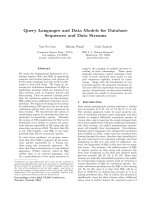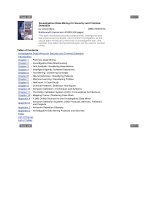Database Security and Auditing: Protecting Data Integrity and Accessibility
Bạn đang xem bản rút gọn của tài liệu. Xem và tải ngay bản đầy đủ của tài liệu tại đây (2.53 MB, 57 trang )
Chapter 1
Security Architecture
Security violations and attacks are
increasing globally at an annual average
rate of 20%.
You serve as a database administrator
to enforce security policies.
Responsibilities can be:
◦ Design and implement a new DB security policy.
◦ Enforce a stringent security policy.
◦ Implement functional specification of a module, i.e. encrypt
the stored data, replace sensitive data using the data
masking pack.
2
Security measures
◦ Prevent physical access to the servers where the data
resided.
◦ Operating systems require authentication of the identity of
computer users.
◦ Implement security models that enforce security measures.
DBA should manage databases and
implement security policies to protect
the data (assets).
3
Define security
Describe an information system and its
components
Define database management system
functionalities
Outline the concept of information security
4
Identify the major components of information
security architecture
Define database security
List types of information assets and their values
Describe security methods
5
Database security: degree to which data is fully
protected from tampering or unauthorized acts
Comprises information system and information
security concepts
6
Wise decisions require:
◦ Accurate and timely information
◦ Information integrity
Information system: comprised of
components working together to produce
and generate accurate information
Categorized based on usage: low-level,
mid-level and high-level
7
8
9
10
Information system components include:
◦
◦
◦
◦
◦
◦
Data
Procedures
Hardware
Software
Network
People
11
12
Client/server architecture:
◦ Based on the business model
◦ Can be implemented as one-tier; two-tier; n-tier
◦ Composed of three layers
Tier: physical or logical platform
Database management system (DBMS):
collection of programs that manage database
13
14
Essential to success of information system
DBMS functionalities:
◦
◦
◦
◦
◦
Organize data
Store and retrieve data efficiently
Manipulate data (update and delete)
Enforce referential integrity and consistency
Enforce and implement data security policies and
procedures
◦ Back up, recover, and restore data
15
DBMS components include:
◦
◦
◦
◦
◦
◦
Data
Hardware
Software
Networks
Procedures
Database servers
16
17
Information is one of an organization’s
most valuable assets
Information security: consists of
procedures and measures taken to protect
information systems components
C.I.A. triangle: confidentiality, integrity,
availability
Security policies must be balanced
according to the C.I.A. triangle
18
19
Addresses two aspects of security:
◦ Prevention of unauthorized access
◦ Information disclosure based on classification
Classify company information into levels:
◦ Each level has its own security measures
◦ Usually based on degree of confidentiality necessary to protect
information
20
21
Consistent and valid data, processed correctly,
yields accurate information
Information has integrity if:
◦ It is accurate
◦ It has not been tampered with
Read consistency: each user sees only his
changes and those committed by other users
22
Employee A learns that his adversarial coworker
is earning higher salary then he is.
A access an application program by accounting
dept and manipulates the vacation hours and
overtime hours of his colleague.
Two security violations:
◦ Confidential data is disclosed inappropriately
◦ An application to modify data was access inappropriately.
There should be a control to cross-check overtime
hours against actual time cards, computes
vacation hours, and verifies entered values. If
they are different, the app requires override from
another person. (data validation)
23
24
25









